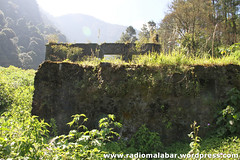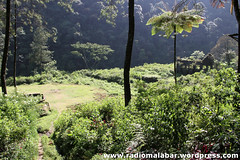Angklung Today: Pushing the Limit of the Shaked Bamboos
Posted by tomsez
 Having been to 20th Anniversary Concert of Gentra Seba, I still remember the first six years of this ensemble. It was when I was the contra bass player for this angklung group of STBA. When it comes to any angklung groups, one thing was always evident: practice, practice, and practice. It was no matter if you were going to go for a performance or not, practice is mandatory. That is not only true as anything to do with performing art should endure such regime of improvement, but also for the fact that, as musical instrument, angklung involves more than one player. Should it be a complex harmony, then it has involve about 20 – 30 players, as each player at a moment could only play one note. The arrangement would also call for each player to be responsible for more than one angklung, leaving a player to memorize his / her parts in several repeating places in a song for those different notes. Back then, no matter how hard to memorize your part, the instructor would always keep saying: feeling. It’s a matter of feeling. Well, imagine what such should imply!
Having been to 20th Anniversary Concert of Gentra Seba, I still remember the first six years of this ensemble. It was when I was the contra bass player for this angklung group of STBA. When it comes to any angklung groups, one thing was always evident: practice, practice, and practice. It was no matter if you were going to go for a performance or not, practice is mandatory. That is not only true as anything to do with performing art should endure such regime of improvement, but also for the fact that, as musical instrument, angklung involves more than one player. Should it be a complex harmony, then it has involve about 20 – 30 players, as each player at a moment could only play one note. The arrangement would also call for each player to be responsible for more than one angklung, leaving a player to memorize his / her parts in several repeating places in a song for those different notes. Back then, no matter how hard to memorize your part, the instructor would always keep saying: feeling. It’s a matter of feeling. Well, imagine what such should imply!
It was initially meant to be a mean of basic music education for children by the founder of this chromatic diatonal version of what was previously played ritually by traditional farmer in pentatonic mode: Daeng Sutigna. Now if a performance repertoire includes the instrumental version of that opera-in-mind ballad, Bohemian Rhapsody, for instance, what would one have in mind ? A leap. Yes, and it could also mean a statement that this musical instrument is capable of playing just about any songs out there. Now It’s more than just a mean of basic music education. It’s A musical instrument. It’s even detached further from it’s original context. It’s performed just like in a classical music concert, with that swinging baton of the conductor. Although in my view, aesthetically, critically speaking, as far as expressiveness inherent in elaboration of any musical instrument would go, they should be aware of its ‘uniqueness’ (you know I could have chosen other word), considering its tonal characteristic.
 That is one of the reason why I put this “pushing the limit”, and it also goes to the spectacular GS performance last night. This is not my overstatement. I was once an insider, one of the players, although not exactly an angklung player. I knew exactly how hard it was for a song to be performed faultless. Being right there at the right moment is one thing. Playing it in a way expressive that would require different dynamics / articulation is another. The repetition of one particular song over and over during the practice would easily tear you down if you don’t have commitment. There you go, if you find any angklung ensemble performance to be beautifully evoking, then it’s not only the melody, the song, the musical arrangement, or the aura of exotism (if you’re a foreigner), but also the hard work. I mean it: the hardwork of the players during the practice sessions!
That is one of the reason why I put this “pushing the limit”, and it also goes to the spectacular GS performance last night. This is not my overstatement. I was once an insider, one of the players, although not exactly an angklung player. I knew exactly how hard it was for a song to be performed faultless. Being right there at the right moment is one thing. Playing it in a way expressive that would require different dynamics / articulation is another. The repetition of one particular song over and over during the practice would easily tear you down if you don’t have commitment. There you go, if you find any angklung ensemble performance to be beautifully evoking, then it’s not only the melody, the song, the musical arrangement, or the aura of exotism (if you’re a foreigner), but also the hard work. I mean it: the hardwork of the players during the practice sessions!
It’s the playback side. Repertoire-wise, check out the playlist : The Power of The Dream (Linda Thompson), Ole-Ole Bandung (Ismail Marzuki), La Vie en Rose (Edith Giovanna / Louis Guglielmi), Kuch Kuch Hota Hai (Sameer / Jatin Lalit), Voices of Spring (Johan Strauss), Pizzicato Polka (Johan Strauss), Love Story (Carl Sigman / Francis Lai), Espana Cani (Pascual Marquina), Kr. Pasar Gambir (NN), Air on G String (J.S. Bach), Bengawan Solo (Gesang), Bohemian Rhapsody (Freddy Mercury / Queen), Speak Softly Love (Larry Kusik / Nino Rota), Eine Kleine Nacht Muziek (W.A. Mozart), We Are The Champion (Freddy Mercury / Queen), We Are The World (Michael Jackson / Lionel Richie), Ibu Pertiwi (NN), Bagimu Negeri (Kusbini).
Ok, one could just put it that there’s no limit, but such surely misses my point. Put off that relativity notion in your head, but would you like to hear Chopin’s Nocturnos played with gongs and yet you still say it could carry the composer’s intention ? Come on. Nonetheless, GS performance was simply outstanding. I could get the feeling on most of the songs, although in some I wish that they could have done it with a little bit more of power. All the players were in smiling faces, no matter how stiff they must be for having the angklungs on their left hand side and the pressure for perfection. I personally liked Pizzicato Polka the most; this one was played with distinct articulation here and there. I bet this is one of the most intricate piece to play, but GS had done it almost faultless, .. Well, I don’t know. I don’t have that perfect pitch, but I really enjoyed that one.
However integration of other instruments still sounded a little bit ear-dissonant to me. I want to refer to those pieces with cello. I forgot the other one, but on Air on G String, that soothing long intro melody was instantly ruined as the cello came in. The other one was quite ok, but on this Bach’s, it didn’t work for me. The cello just didn’t blend. Yes, it was not a perfect gig. One of the mikes went dead on Kuch Kuch Hota Hai, not to mention the sound system that kept humming now and then.
Anyway, GS is so lucky to have the best duo-angklung-instructors in the world (Yes, in the world!): those are Pak Obby A.R. Wiramihardja and Pak Eddy Permadi. The former is said to be a direct successor of Pak Daeng Sutigna as the founder himself handed over the will to develop angklung. Another figure worth mentioning was (the late) Ibu Wiwi Martalogawa. She was the founder of Gentra Seba 20 years ago. That night GS gave her special honorary award for her pioneering efforts. She was behind all this in the first place.
I don’t know why I was so stunned by the whole show. When I played the contra bass for GS, I was much inside of the group and everything was just like that one familiar sound. Could it be that it was because now I am a spectator, out of the box ?
Hat’s off Gentra Seba. Happy 20th Anniversary.
Posted on 06/01/2012, in Social and tagged Angklung. Bookmark the permalink. Leave a comment.













Leave a comment
Comments 0